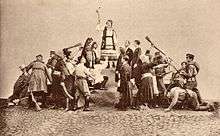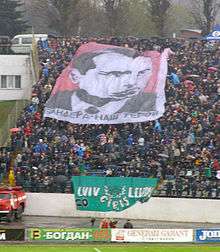Ukrainian nationalism
Ukrainian nationalism is the ideology promoting the unity of Ukrainians into their own nation state. Although the current Ukrainian state emerged fairly recently, some historians, such as Mykhailo Hrushevsky, Orest Subtelny and Paul Robert Magocsi, have cited the medieval state of Kievan Rus' as an early precedent of specifically Ukrainian statehood.[1] The origins of modern Ukrainian nationalism have also been traced to the 17th-century Cossack uprising against the Polish–Lithuanian Commonwealth, led by Bohdan Khmelnytsky.
Part of a series on the |
|---|
| History of Ukraine |
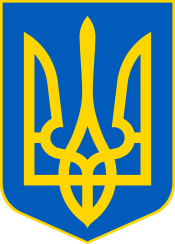 |
|
Early history
|
|
Modern history
|
|
Topics by history |
|
|
Cossack nationalism
The Cossacks played a role in re-awakening a Ukrainian sense of identity within the steppe region.[2] A dominant figure within the Cossack movement and in Ukrainian nationalist history, Bohdan Khmelnytsky (c. 1595 – 1657), commanded the Zaporozhian Cossacks and led the Khmelnytsky Uprising against Polish rule in the mid-17th century. Khmelnytsky also succeeded in legitimizing a form of democracy which had been practiced by cossacks since the 15th century.[3] This sense of democracy played a key part of the sense of ethnic identity. Bohdan Khmelnytsky spoke of the liberation of the "entire Ruthenian people" and recent research has confirmed that the concept of a Ruthenian nation as a religious and cultural community had existed before his revolution.[4] Modern Ukrainians still remember and glorify Khmelnytsky's role in the history of Ukraine.
Another prominent figure in Cossack nationalism, Hetman Ivan Mazepa (1639-1709), made large financial contributions focused on the restoration of Ukrainian culture and history during the early 18th century. He financed major reconstructions of the Saint Sophia Cathedral in Kiev,[5] and the elevation the Kyiv Mohyla Collegium to the status of Kyiv Mohyla Academy in 1694.[5] Politically, however, Mazepa was misunderstood and misrepresented, and found little support among the peasantry.[6]
Ukrainian nationalism in literature
One of the most prominent figures in Ukrainian national history, the Ukrainian poet Taras Shevchenko, voiced ideas of an independent and sovereign Ukraine in the 19th century.[7] Taras Shevchenko used poetry to inspire cultural revival to the Ukrainian people and to strive to overthrow injustice.[7] Shevchenko died in Saint Petersburg on March 10, 1861, the day after his 47th birthday. Ukrainians - not only the citizens of Ukraine, but Ukrainians who live throughout the world - regard him as a national hero. His collection of poetry Kobzar was the second book in almost every Ukrainian household in the beginning of 20th century (after the Bible). He became a symbol of the national cultural revival of Ukraine.
Beside Shevchenko numerous other poets have written in Ukrainian. Among them, Volodymyr Sosyura in his poem Love Ukraine (1944) stated that one cannot respect other nations without respect for one's own.
Ukrainian nationalism in the 20th century
World War I
With the collapse of the Russian Empire a political entity which encompassed political, community, cultural, and professional organizations was established in Kiev from the initiative from the Association of the Ukrainian Progressionists (abbr. TUP). This entity was called the "Tsentralna Rada" (Central Council) and was headed by the historian, Mykhailo Hrushevskyi.[8] On January 22, 1918, the Tsentralna Rada declared Ukraine an independent country.[8] This independence was recognized by the Russian government headed by Lenin, as well as the Central Powers and other states.[9] However, this government did not survive very long because of pressures not only from Denikin's Russian White Guard, but also the Red Army, German and Entente intervention, and local anarchists such as Nestor Makhno and Green Army of Otaman Zeleny.[8]
.jpg)
Interwar period in Soviet Ukraine
As Bolshevik rule took hold in Ukraine, the early Soviet government had its own reasons to encourage the national movements of the former Russian Empire.
Until the early-1930s, Ukrainian culture enjoyed a widespread revival due to Bolshevik concessions known as the policy of Korenization ("indigenization"). In these years an impressive Ukrainization program was implemented throughout the republic. In such conditions, the Ukrainian national idea initially continued to develop and even spread to a large territory with traditionally mixed population in the east and south that became part of the Ukrainian Soviet Socialist Republic.
At the same time, despite the ongoing Soviet-wide anti-religious campaign, the Ukrainian national Orthodox Church was created, the Ukrainian Autocephalous Orthodox Church. The church was initially seen by the Bolshevik government as a tool in their goal to suppress the Russian Orthodox Church, always viewed with great suspicion by the regime for its being the cornerstone of the defunct Russian Empire and the initially strong opposition it took towards the regime change. Therefore, the government tolerated the new Ukrainian national church for some time and the UAOC gained a wide following among the Ukrainian peasantry.
These events greatly raised the national consciousness among the Ukrainians and brought about the development of a new generation of Ukrainian cultural and political elite. This in turn raised the concerns of Joseph Stalin, who saw danger in the Ukrainians' loyalty towards their nation competing with their loyalty to the Soviet State and in early 1930s the "Ukrainian bourgeois nationalism" was declared to be the primary problem in Ukraine. The Ukrainization policies were abruptly and bloodily reversed, most of the Ukrainian cultural and political elite was arrested and executed, and the nation was decimated with the famine called the Holodomor.
Interwar period in modern-day Western Ukraine
After World War I, lands of what is today Western Ukraine were incorporated into newly restored Poland. Tadeusz Hołówko died in Truskawiec (Truskavets) on August 29, 1931, one of the first victims of an assassination campaign carried out by militants of the Organization of Ukrainian Nationalists (OUN). On 15 June 1934, Bronisław Pieracki was assassinated by a Ukrainian nationalist from the Organization of Ukrainian Nationalists.
World War II
With the outbreak of war between Nazi Germany and the Soviet Union in 1941, many nationalists in Ukraine thought that they would have an opportunity to create an independent country once again. An entire Ukrainian volunteer division of the SS had been created.
Many of the fighters who had originally looked to the Nazis as liberators, quickly became disillusioned and formed the Ukrainian Insurgent Army (UPA) (Ukrainian: Українська Повстанська Армія - У.П.А.), which waged military campaign against Germans and later Soviet forces as well against Polish civlians.[10] The primary goal of OUN was “the rebirth, of setting everything in order, the defense and the expansion of the Independent Council of Ukrainian National State”. OUN also revived the sentiment that “Ukraine is for Ukrainians”.[11] In 1943, the UPA adopted a policy of massacring and expelling the Polish population.[12][13] The ethnic cleansing operation against the Poles began on a large scale in Volhynia in late February (or early Spring[13]) of that year and lasted until the end of 1944.[14] 11 July 1943 was one of the deadliest days of the massacres, with UPA units marching from village to village, killing Polish civilians. On that day, UPA units surrounded and attacked 99 Polish villages and settlements in three counties – Kowel, Horochów, and Włodzimierz Wołyński. On the following day 50 additional villages were attacked.[15]
On June 30, 1941, the OUN, led by Stepan Bandera, declared an independent Ukrainian state.[16] This was immediately acted upon by the Nazi army, and Bandera was arrested and imprisoned from 1941 to 1944.[16]
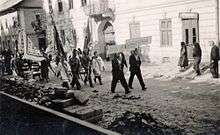
The UPA was a military group that took up arms first against the Poles, and later, Nazis and eventually against the Soviets. During World War II, the UPA fought against the Polish, German and Soviet forces. After the Second World War, UPA took actions directed against Soviet rule within Ukraine. Many members of the UPA saw themselves as the armed wing of the OUN in its struggle for Ukrainian independence.[17]
There has been much debate as to the legitimacy of UPA as a political group. UPA maintains a prominent and symbolic role in Ukrainian history and the quest for Ukrainian independence.[18] At the same time it was deemed an insurgent or terrorist group by Soviet historiography.[18]
Ukrainian Canadian historian Serhiy Yekelchyk writes that during 1943 and 1944 an estimated 35,000 Polish civilians and an unknown number of Ukrainian civilians in the Volhynia and Chelm regions fell victim to mutual ethnic cleansing by the UPA and Polish insurgents.[19] Niall Ferguson writes that around 80,000 Poles were murdered then by Ukrainian nationalists.[20] Norman Davies in his book Europe at War 1939–1945: No Simple Victory puts the number of murdered Polish civilians at between 200,000 and 500,000, while Timothy Snyder writes that Ukrainian nationalists killed "between forty to sixty thousand Polish civilians in Volhynia in 1943".[21]
Declaration of state sovereignty (1991)
On 24 August 1991, the Supreme Soviet of the Ukrainian SSR (which became the Ukrainian parliament) enacted a declaration by which Ukraine seceded from the Soviet Union and became a sovereign state.[22]
Ukrainian nationalism in present-day Ukraine
In the first decade of the 21st century voters from Western Ukraine and Central Ukraine tended to vote for pro-Western and pro-European general liberal national democrats[23][24] While in Eastern Ukraine and Southern Ukraine pro-Russian parties got the vote.[23]
From the 1998 parliamentary elections[a 1][25][26][27] until the 2012 parliamentary elections no nationalist party obtained seats in the Verkhovna Rada (Ukraine's parliament).[28][29] In these elections nationalist right wing parties obtained less than 1% of the votes; in the 1998 elections they obtained 3.26%.[29]
The nationalist party Svoboda had an electoral breakthrough with the 2009 Ternopil Oblast local election when they obtained 34.69% of the votes and 50 seats out of 120 in the Ternopil Oblast Council.[29] This was the best result for a far-right party in Ukraine’s history.[29] In the previous 2006 Ternopil Oblast local election the party had obtained 4.2% of the votes and 4 seats.[29] In the simultaneously held local elections for the Lviv Oblast Council it had obtained 5.62% of the votes and 10 seats and 6.69% of the votes and 9 seats in the Lviv city council.[29] In 1991 Svoboda was founded as the 'Social-National Party of Ukraine'.[30] The party combined radical nationalism and alleged neo-Nazi features.[31] It was renamed and rebranded 13 years later as 'All-Ukrainian Association Svoboda' in 2004 under Oleh Tyahnybok. Political scientists Olexiy Haran and Alexander J. Motyl contend that Svoboda is radical rather than fascist and they also argue that it has more similarities with Far-Right movements like the Tea Party than it has with either fascists or neo-Nazis.[32][33] In 2005 Victor Yushchenko appointed Volodymyr Viatrovych head of the Ukrainian security service (SBU) archives. According to Professor Per Anders Rudling, this not only allowed Viatrovych to sanitize ultra nationalist history, but it also allowed him to officially promote its dissemination along with OUN(b) ideology which is based on 'ethnic purity' coupled with anti-Russian, anti-Polish and anti-semitic rhetoric.[34]:229–230 The extreme right wing now capitalizes on 'Yushchenkoist' propaganda initiatives.[34]:235 This includes Iuryi Mykhal'chyshyn, an ideologue who proudly confesses that he is a part of the fascist tradition.[34]:240 The autonomous nationalists focus on recruiting young people, participating in violent actions, and advocating "anti-bourgeoism, anti-capitalism, anti-globalism, anti-democratism, anti-liberalism, anti-bureaucratism, anti-dogmatism". Per Anders Rulig has suggested that Ukrainian President (sworn in on 25 February 2010[35]) "Viktor Yanukovych has indirectly aided Svoboda" by "granting Svoboda representatives disproportionate attention in the media".[34]:247
In the 2010 Ukrainian local elections Svoboda achieved notable success in Eastern Galicia.[36] In the 2012 parliamentary elections Svoboda came in fourth with 10,44% (almost a fourteenfold of its votes compared with the 2007 parliamentary elections[26][37]) of the national votes and 38 out of 450 seats.[38][39] Following the 2012 Ukrainian parliamentary election Batkivshchyna and UDAR cooperated officially with Svoboda.[40]

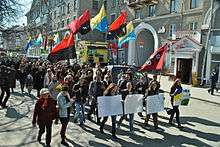
The topic of Ukrainian nationalism and its alleged relationship to Neo-Nazism came to the fore in polemics about the more radical elements involved in the 2013-2014 Euromaidan protests and subsequent Russian military intervention in Ukraine from 2014 onward. Russian media has attempted to portray the Ukrainian party in the conflict as Nazi, while at the same time key ideologies in the pro-Russian side, such as the former National Bolshevik-figure Aleksandr Dugin themselves claim intellectual influence from the likes of Heinrich Himmler of the Waffen-SS. The main Ukrainian organisations involved with a neo-Banderaite legacy are Svoboda, Right Sector and Azov Battalion. The Azov Battalion is led by Andriy Biletsky, the head of the ultra-nationalist and neo-Banderaite political groups Social-National Assembly and Patriots of Ukraine,[41] is commander of the Azov Battalion[42] and the Azov Battalion is part of the Ukrainian National Guard[43] fighting pro-Russian separatists in the War in Donbass.[44][45] According to a report in The Daily Telegraph, some individual anonymous members of the battalion identified themselves as sympathetic to the Third Reich.[42] In June 2015, Democratic Representative John Conyers and his Republican colleague Ted Yoho offered bipartisan amendments to block the U.S. military training of Ukraine's Azov Battalion.[43]
After President Yanokovych's ouster in the February 2014 Ukrainian revolution, the interim Yatsenyuk Government placed 4 Svoboda members in leading positions: Oleksandr Sych as Vice Prime Minister of Ukraine, Ihor Tenyukh as Minister of Defense, lawyer Ihor Shvaika as Minister of Agrarian Policy and Food and Andriy Mokhnyk as Minister of Ecology and Natural Resources of Ukraine.[46] The U.S. State Department has stated in a 5 March 2014 fact sheet that "Far-right wing ultranationalist groups, some of which were involved in open clashes with security forces during the Euromaidan protests, are not represented in the Ukrainian parliament."[47]
In the 2014 Ukrainian presidential elections and 2014 parliamentary elections, Svoboda candidates failed to meet the electoral threshold to win. The party won 6 constituency seats in the 2014 parliamentary election and it obtained 4.71% of national election list votes.[48] In the 2014 presidential election Svoboda leader Oleh Tyahnybok received 1.16% of the vote.[49] Right Sector leader Dmytro Yarosh gained 0.7% of the votes in the 2014 presidential election,[49] and he was elected to parliament in the (2014) parliamentary election as a Right Sector candidate by winning a single-member district.[50] Right Sector spokesperson Boryslav Bereza as an independent candidate also won a seat and district.[51]
The radical nationalists group С14, whose members openly expressed neo-Nazi views, gained notoriety in 2018 for being involved in violent attacks on Romany camps.[52][53][54]
On 19 November 2018 Svoboda and fellow Ukrainian nationalist political organizations Organization of Ukrainian Nationalists, Congress of Ukrainian Nationalists, Right Sector and C14 endorsed Ruslan Koshulynskyi's candidacy in the 2019 Ukrainian presidential election.[55] In the election he received 1.6% of the votes.[56] In the 2019 Ukrainian parliamentary election a joined a united party list with the nationalist right wing parties Svoboda, Right Sector, Governmental Initiative of Yarosh and National Corps won not enough votes to clear the 5% election threshold, they won 2.15% of the vote, and thus no parliamentary seats.[57][58] Svoboda did win 1 constituency seat in the election.[57] Boryslav Bereza and Dmytro Yarosh lost their parliamentary seats.[57]
Soviet Union and Ukrainian bourgeois nationalism

In Soviet ideology there exists the concept of Ukrainian bourgeois nationalism (UBN) (Ukrainian: Український буржуазний націоналізм, (УБН)). This nationalism was presented as a form of an anti-socialist and counterrevolutionary, "bourgeois" movement. All counter-revolutionary activities were persecuted by the Article 58 of the 1922 Russian Criminal Code. The definition of Ukrainian bourgeois nationalism was well put in the foreword of a Soviet book from the 1950s "Under foreign flags" by Volodymyr Byelyayev. The book claimed that Ukrainian bourgeois nationalism was invented by the "archenemy" of the Ukrainian people, the historian Mykhailo Hrushevsky, whom the author claimed to have been a German spy. Hrushevsky enjoyed great political and public popularity and respect, so the Soviet government resorted to negative public relations against him. These accusations were recently reiterated by the doctor of historical sciences Vitaliy Sarbei who was published by the Russian information agency "Rosbalt" (February 2011). The book "Under foreign flags" gives the following definition of Ukrainian bourgeois nationalism:
Ukrainian bourgeois nationalism is the ideology and politics of the Ukrainian bourgeoisie. Exploiting society, the social base of Ukrainian bourgeois nationalism was a stratum made up of all urban and rural bourgeoisie starting from the big capitalists, owners of big industrial enterprise, and finishing with numerous layers of the bourgeois class under capitalism, kurkul. The economic base for the growth of Ukrainian bourgeois nationalism in the epoch of imperialism is the same as for that of any nationality, that is, the increase of imperialist competition for sales markets and raw materials.
Ukrainian bourgeois nationalism was a cliché of Soviet phraseology such as "Proletarian internationalism", "Fraternity of peoples", "Agitprop", "Stakhanovite movement", "Enemy of the people" and numerous others. According to Soviet ideology Ukrainian bourgeois nationalism was a specific form of bourgeois nationalism recognizing the superiority of national interests over class interests (see Class in Marxist theory). The idea of bourgeois nationalism was required to keep consistency with the Bolshevik's Declaration of the Rights of the Peoples of Russia which set a wave of secession movements across the former Russian Empire. This concept of nationalism was also used to identify everyone who did not share the national policy principles of the Communist Party (Bolsheviks), proletarian internationalism, and did not fit under the definition of bourgeois cosmopolitanism. In Soviet ideology, bourgeois cosmopolitanism was a negative phenomenon and opposite to the proclaimed fraternity of peoples.
The term first appeared in the 1920s in the documents of the Communist Party and spread into Soviet journalism and science literature. It was needed as an ideological device. Similarly, Soviet historiography equated Ukrainian nationalism with fascism and with Nazism despite the fact that racism and cult of personality were extrinsic to Ukrainian nationalism, which was its distinction.
Nationalist political parties
Current
- People's Movement of Ukraine (1990–present)
- Congress of Ukrainian Nationalists (1992–present)
- Freedom (1995–present)
- All-Ukrainian Union "Fatherland" (1999–present)
- Ukrainian People's Party (2002–present)
- Ukrainian Republican Party (2006–present)
- Radical Party of Oleh Lyashko (2010–present)
- Right Sector (2013–present)
- People's Front (2014–present)
- UKROP (2015–present)
- National Corps (2016–present)
Defunct
- Ukrainian Radical Party (1890–1940)
- Revolutionary Ukrainian Party (1900–1905)
- Borotbists (1918–1920)
- All-Ukrainian Political Movement "State Independence of Ukraine" (1990–2003)
- Social-National Party of Ukraine (1991–2004)
See also
- Greater Ukraine
- Ukrainian National Revival
- Ukrainophilia
- Ukrainization
- Far-right politics in Ukraine
- Neo-Nazism in Ukraine
Notes
- In the 1998 parliamentary elections the radical nationalist bloc of parties (Social-National Party of Ukraine and "State Independence of Ukraine") called "Less Words" (Ukrainian: Менше слів) collected 0.16% of the national vote but from the bloc (only) Oleh Tyahnybok was voted into Parliament.
References
- ^ Hrushevsky, Mykhaylo. History of Ukraine. Chartorsky Publishing, New York, 1961. p. 119
- Wilson, Andrew. Ukrainian Nationalism in the 1990s: A Minority Faith. Cambridge University Press. London: 1997. 6.
- "Ministry for Foreign Affairs of Ukraine - Publications". Mfa.gov.ua. Archived from the original on 2010-12-29. Retrieved 2010-04-18.
- Serhy Yekelchyk. Ukraine Birth of a Modern Nation. Oxford University Press, 2007. p 28
- "Mazepa, Ivan". Encyclopediaofukraine.com. Retrieved 2010-04-18.
- Orest Subtelny, "Ukraine: a History", University of Toronto Press, 2000, ISBN 0-8020-8390-0, p. 164
- Kleiner, Israel. From Nationalism to Universalism Vladmir (Ze’ev) Jabotinsky and the Ukrainian Question. Canadian Institute of Ukrainian Studies. Edmonton: 2000. 66.
- Ukraine. MSN Encarta. Archived from the original on 10 December 2006.
- "Treaty of Brest-Litovsk". The Columbia Encyclopedia, 6th ed. 2016. Retrieved 1 April 2016.
- Wilson, Andrew. Ukrainian Nationalism in the 1990s: A Minority Faith. Cambridge University Press. London: 1997.47-51.
- Wilson, Andrew. Ukrainian Nationalism in the 1990s: A Minority Faith. Cambridge University Press. London: 1997. 48.
- Martin, Terry (December 1998). "The Origins of Soviet Ethnic Cleansing" (PDF). The Journal of Modern History. The University of Chicago Press. 70 (4): 820. doi:10.1086/235168. Retrieved 3 May 2018.
- Timothy Snyder. The Reconstruction of Nations. Poland, Ukraine, Lithuania, Belarus, 1569–1999. Yale University Press. 2003. pp. 168-170, 176
- "16" (PDF). Organization of Ukrainian Nationalists and the Ukrainian Insurgent Army. Institute of Ukrainian History, Academy of Sciences of Ukraine. pp. 247–295.
- Grzegorz Motyka, Ukraińska Partyzantka 1942–1960, Warszawa 2006, p. 329
- "Bandera, Stepan". Encyclopediaofukraine.com. Retrieved 2010-04-18.
- "The UPA - Ukrainian Insurgent Army - - www.upa.com.ua". Tern.ukrpack.net. Archived from the original on 2008-05-27. Retrieved 2010-04-18.
- Wilson, Andrew. Ukrainian Nationalism in the 1990s: A Minority Faith. Cambridge University Press. London: 1997. 51.
- Serhy Yekelchyk Ukraine: Birth of a Modern Nation, Oxford University Press (2007), ISBN 978-0-19-530546-3, page 144
- Niall Ferguson, The War of the World, Penguin Press, New York 2006, page 455
- Snyder, Timothy (2006-03-22). The Reconstruction of Nations By Timothy Snyder, page 170. ISBN 978-0-300-10586-5. Retrieved 2010-04-18.
- A History of Ukraine: The Land and Its Peoples by Paul Robert Magocsi, University of Toronto Press, 2010, ISBN 1442610212 (page 722/723)
- Eight Reasons Why Ukraine’s Party of Regions Will Win the 2012 Elections by Taras Kuzio, The Jamestown Foundation (17 October 2012)
UKRAINE: Yushchenko needs Tymoshenko as ally again Archived 2013-05-15 at the Wayback Machine by Taras Kuzio, Oxford Analytica (5 October 2007) - Nations and Nationalism: A Global Historical Overview, ABC-CLIO, 2008, ISBN 1851099077 (page 1629)
Ukraine on its Meandering Path Between East and West by Andrej Lushnycky and Mykola Riabchuk, Peter Lang, 2009, ISBN 303911607X (page 122) - Elections of People's Deputies of Ukraine on March 29, 1998 the Election programmes of political parties and electoral blocs, Vernadsky National Library of Ukraine (1998)
Central Election Commission of Ukraine
Candidates list for Less words, Central Election Commission of Ukraine - (in Ukrainian)Всеукраїнське об'єднання «Свобода», Database ASD
- (in Ukrainian) Олег Тягнибок, Ukrinform
- After the parliamentary elections in Ukraine: a tough victory for the Party of Regions, Centre for Eastern Studies (7 November 2012)
- Shekhovtsov, Anton (2011)."The Creeping Resurgence of the Ukrainian Radical Right? The Case of the Freedom Party". Europe-Asia Studies Volume 63, Issue 2. pp. 203-228. doi:10.1080/09668136.2011.547696 (source also available here )
- "Svoboda Fuels Ukraine’s Growing Anti-Semitism". Algemeiner Journal. 24 May 2013.
- Ivan Katchanovski interview with Reuters Concerning Svoboda, the OUN-B, and other Far Right Organizations in Ukraine, Academia.edu (4 March 2014)
- Motyl, Alexander J. (21 March 2014). "'Experts' on Ukraine". World Affairs Journal.
- Miller, Christopher (17 January 2014). "Svoboda's rise inspires some, frightens many others". Kyiv Post. Retrieved 5 February 2014.
- Rudling, Per Anders (2013). "12:The Return of the Ukrainian Far Right The Case of VO Svoboda". In Ruth Wodak; John E. Richardson; Michelle Lazar (eds.). Analysing Fascist Discourse European Fascism in Talk and Text. New York: Routledge. pp. 228–255. Retrieved 12 March 2014.
- New Ukraine president pledges neutrality, Agence France-Presse (24 February 2010) Archived 2 March 2010 at the Wayback Machine
- Local government elections in Ukraine: last stage in the Party of Regions’ takeover of power, Centre for Eastern Studies (October 4, 2010)
- Svoboda: The rise of Ukraine's ultra-nationalists, BBC News (26 December 2012)
- Ukraine’s Ultranationalists Show Surprising Strength at Polls, Nytimes.com (8 November 2012)
- (in Ukrainian)Proportional votes, Central Electoral Commission of Ukraine
- Batkivschyna, UDAR, Svoboda to create opposition council to coordinate activity in Rada, Kyiv Post (17 December 2012)
Batkivschyna, UDAR, Svoboda to coordinate their actions at presidential election, Interfax-Ukraine (16 May 2013) - "Ukraine conflict: 'White power' warrior from Sweden". BBC News. 16 July 2014.
- "Ukraine crisis: the neo-Nazi brigade fighting pro-Russian separatists". The Daily Telegraph. 11 August 2014.
- "Ukraine's Neo-Nazis Won't Get U.S. Money". Bloomberg. 12 June 2015.
- "Azov fighters are Ukraine's greatest weapon and may be its greatest threat". The Guardian. 10 September 2014.
- "German TV Shows Nazi Symbols on Helmets of Ukraine Soldiers". NBC News.
- "Ukraine's revolution and the far right". BBC News. 7 March 2014.
- Office of the Spokesperson (5 March 2014). "President Putin's Fiction: 10 False Claims About Ukraine". Fact sheet. Washington, DC: U.S Department of State. Retrieved 11 March 2014.
- Poroshenko Bloc to have greatest number of seats in parliament Archived 10 November 2014 at the Wayback Machine, Ukrainian Television and Radio (8 November 2014)
People's Front 0.33% ahead of Poroshenko Bloc with all ballots counted in Ukraine elections – CEC, Interfax-Ukraine (8 November 2014)
Poroshenko Bloc to get 132 seats in parliament – CEC, Interfax-Ukraine (8 November 2014) - "Poroshenko wins presidential election with 54.7% of vote - CEC". Radio Ukraine International. 29 May 2014. Archived from the original on 29 May 2014.
(in Russian) Results election of Ukrainian president, Телеграф (29 May 2014) - Кандидати на мажоритарних округах - Одномандатный избирательный округ № 39 [Candidates in majority districts - Single-mandate constituency № 39] (in Russian). RBK Ukraine. 26 October 2014. Archived from the original on 23 December 2014.
"Extraordinary parliamentary election on 26.10.2014: Data on vote counting at precincts within single-mandate districts". Central Election Commission of Ukraine. 29 October 2014. Archived from the original on 29 October 2014. - Кандидати на мажоритарних округах: Одномандатный избирательный округ № 213 [Candidates for single-mandate constituencies: single-mandate constituency № 213] (in Ukrainian). RBK Ukraine. 25 October 2014. Archived from the original on 9 December 2014., RBK Ukraine
(in Ukrainian) Boryslav Bereza very short bio Archived 2014-12-09 at the Wayback Machine, RBK Ukraine
Video of first brawl in Verkhovna Rada becomes a YouTube hit, Kyiv Post (5 December 2014) - Ukrainian Militia Behind Brutal Romany Attacks Getting State Funds, Radio Free Europe (June 14, 2018)
- Ukraine Roma camp attack leaves one dead, BBC News (24 June 2018)
- SBU opens case against C14 nationalists for detention of Brazilian mercenary – lawyer, UNIAN (18 June 2018)
- (in Ukrainian) The nationalists have been identified with a presidential candidate, Ukrayinska Pravda (19 November 2018)
- Zelenskiy wins first round but that’s not the surprise, Atlantic Council (4 April 2019)
- CEC counts 100 percent of vote in Ukraine's parliamentary elections, Ukrinform (26 July 2019)
(in Russian) Results of the extraordinary elections of the People's Deputies of Ukraine 2019, Ukrayinska Pravda (21 July 2019) - (in Ukrainian) Yarosh, Tyagnibok and Biletsky have all formed a single list for the elections, Glavcom (9 June 2019)
Further reading
- Alexander F. Tsvirkun History of political and legal Teachings of Ukraine, Kharkiv, 2008
- John Alexander Armstrong, "Ukrainian Nationalism", Columbia University Press, 1963, LCCN 62-18367
- Alexander J. Motyl, "The turn to the right : the ideological origins and development of Ukrainian nationalism, 1919-1929", Published: Boulder, [Colo. : East European quarterly] ; New York : distributed by Columbia University Press, 1980, ISBN 0-914710-58-3
- Kenneth C. Farmer, "Ukrainian nationalism in the post-Stalin era : myth, symbols, and ideology in Soviet nationalities policy", Kluwer Boston, 1980, ISBN 90-247-2401-5
- Andrew Wilson, "Ukrainian Nationalism in the 1990s: A Minority Faith", Cambridge University Press, 1996, ISBN 0-521-57457-9
- Ernst B. Haas, "Nationalism, Liberalism, and Progress", Cornell University Press, 1997, ISBN 0-8014-3108-5, Chapter seven: Russia and Ukraine, pp. 324–410
- Ronald Grigor Suny, Revenge of the Past: Nationalism, Revolution, and the Collapse of the Soviet Union", Stanford University Press, 1993, ISBN 0-8047-2247-1
- Paul Robert Magocsi, "The Roots of Ukrainian Nationalism: Galicia As Ukraine's Piedmont", University of Toronto Press, 2002, ISBN 0-8020-4738-6
- Andrew Wilson, "The Ukrainians: Unexpected Nation", Yale University Press, 2002, ISBN 0-300-09309-8
External links
- Ukrainian nationalist news aggregator with English translations
- Ukrainian Patriot's Credo, a poem by Basil Bucolic
- Oleksandr Palchenko. Ukrainian nation and Ukrainian people. First Social Agreement.
- "Bourgeois nationalists": as they were depicted by the Soviet propaganda. Ukrayinska Pravda
- Bourgeois nationalism. Ukrainian Tyzhden. Fall 2011.
- Liu Shaoqi. Internationalism and nationalism
- Lewis, T. Marxism and Nationalism. "International Socialist Review" Issue 13. August–September 2000

